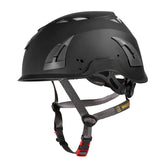If you want to comply with the latest health and safety practices when erecting a scaffold, you’re going to need an anchor testing kit.
But choosing the right kit for your needs can be tricky. It’s an important decision to make.
Furthermore, the correct selection, installation and testing of scaffold anchor ties is critical to the overall safety and stability of scaffold structures of all types, so we need to do all we can to operate as safely as possible.
At Leach’s, we want to make that process simple and safe.
In this blog, we’ll help you decide which anchor test kit is right you, as well as detail the process of correctly testing scaffold anchors for strength and stability for the normal use of scaffold structures.
Anchor testing – which kit should I choose?
There are a range of anchor tests out there to choose from. You may’ve already guessed it, but we’re big advocates of the BIGBEN Anchor Test Kit. Combining precision and quality, this kit is the ideal tool for establishing safe working loads or validating the correct installation of existing fixings. It’s also faster to work with than some if it’s rivals, with an easy set-up process and tooling change function. Here are just a few of our favourite features:
- Faster to work with
- Easier to set up & change tooling
- Lightweight & safe to use
- Easy read gauge with rubber protector
- All new design eliminates oil loss and seepage
- Better engineered for less maintenance & longer life
- Snap & go tooling
Now we’ve chosen our anchor test kit, it’s time to delve into the main factors of effective scaffold anchor testing.
Loading direction
The capacity of anchor points can vary greatly depending on the load direction. There are essentially two different types of loads, horizontal and vertical.
Horizontal loads - This is the major load a typical tie assembly must cope with. It usually originates from wind loads which are transferred to the anchors as either compression or tension loads.
Vertical loads - Often referred to as shear loads and bending loads, in most cases vertical loads are transferred down the scaffold, through standards to the ground. However, in scenarios where the scaffold is supported by a building structure, or where it supports a temporary roof which are typically affected by wind uplift, vertical shear loads may arise. If this is the case, a specially designed anchor may be required.
The bending capacity for standard anchors is generally very low, so efforts to minimise loading of this nature are critical to the overall stability and strength of the scaffold. This will be considered by the engineer during the design production.
Preliminary tests
If there is ever any doubt as to the adequacy of the base material in which the anchors will be installed, preliminary tests should be carried out so we can be confident the type of anchor being used is suitable for the building substrate.
Proof testing anchors
Proof testing should be carried on at least 3% or 5% (1 in 20) of all installed anchors once they have been installed to ensure their strength and stability. This number applies to the following separate areas:
- Different fixings that may have been used
- Where the base material is different
- Where the condition of the base material has been affected by weather conditions on a different elevation
- Where a different team of installers has worked
Anchors should be tested to a load of 1.25 times the working load. It is good practice for all tested anchors to be clearly identified with a tag outlining the date of the test and the load applied. The testing should be performed by a trained and competent individual who should preferably be independent of the installer/installation team.
Should anchors be installed into mortar joints then the testing regime should be doubled from 1 in 20 (5%) to 1 in 10 (10%).
Failed anchors
Should one anchor fail a test, then the test frequency should be doubled to at least 10% of all anchors and a minimum of six. Should two anchors fail then the test frequency should be doubled again to 1 in 5 and a minimum of twelve. More than two failures should be treated as a serious issue, with a thorough review of the fixing and installation methods being carried out, prior to continuing.
Regular examination
Fixed Anchors should be re-examined at regular intervals and it is normal to do so during statutory scaffold inspections. Additional checks may be required following events that may have affected the structure, such as high winds or accidental vehicle contact. For more information on scaffold inspections, check out this article looking at how often scaffolds should be inspected.
Corrosion of scaffold anchors
Although scaffold tie anchors are regarded as temporary fixings (up to two years being regarded as the definition of temporary) rust and corrosion will take place if let unprotected in the structure. It is therefore recommended that structures remaining in place for more than 12 months go through thorough re-testing.
The purpose of this article is to cover the basics for effective scaffold anchor testing. For more detailed information on anchor testing, please click the links below. Alternatively, if you have a requirement for equipment advice or have any further questions please contact us on sales@www.leachs.com or 01432 346 890.
Scaffold Anchor Testing: Related articles:


















